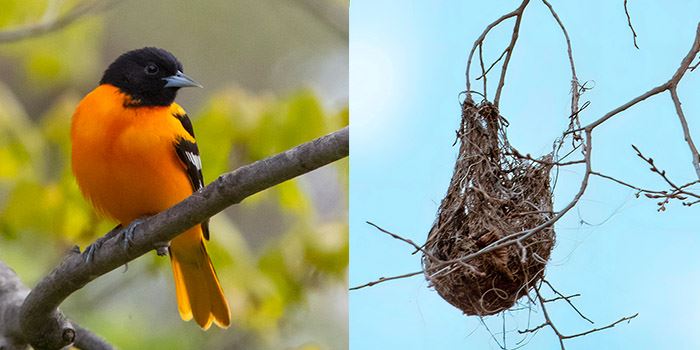Woven Masterpieces

By: Karen Menard
A few small, round baskets suspended from tree branches recently caught my attention while driving down River Rd. A better look revealed that they were not dangling holiday ornaments, but, indeed, former Baltimore oriole nests being tossed and bounced around in the windy conditions.
Orioles typically migrate to northwest Ohio in April from the Caribbean, Central and/or South America and then leave our area mid-summer, spending only about one-third of their year with us in Ohio. Why risk long-distance challenges and expend a large amount of energy flying thousands of miles? Northwest Ohio offers prime breeding habitats with plenty of insect availability-especially where the Maumee River is concerned. Many nests are built in cottonwood trees near the Jerome Rd. rapids, an area high in insect life and a quick, easy meal for hungry oriole chicks! Fast food convenience isn’t just a perk for humans, but for the birds, as well.
Strategic nest placement is not only important for easy sustenance, but also for locating appropriate nest making materials. The downy fluff produced by cottonwood trees is collected by male orioles to line the bottom of the nest as a perfect egg cushion. Both the male and female will also collect strong, weather resilient fibers from milkweeds, dogbane, grapevines, and strips of tree bark and grasses.
However, the female is the master engineer when it comes to skillfully weaving the complex creation. Working dutifully for one to two weeks, she starts by winding long strands around the upper branches to create support for the nest. Almost like knitting a purse, with her beak as a type of needle, she is able to assemble thousands of knots and stitches through rapid thrust and draw movements. The result is one durable, long-lasting woven pouch capable of providing an amazingly safe shelter in tough weather conditions. This pouch or bag design consisting of a narrow, three inch wide opening at the top better ensures fledgling survival from predators, as well.
This winter, these rugged masterpieces will continue to serve as hopeful reminders of what nature will bring us next season. Come spring, orioles will return to the same area near Jerome Rd. and weave new nests for the next generation.
Did You Know? Many Oriole nests found in the early 20th Century, when horses were a major means of transportation, were exclusively made from horsehair, a very strong fiber.
Photos by Art Weber